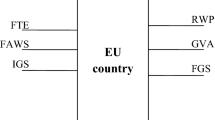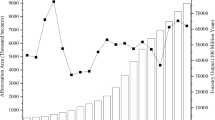Abstract
Data Envelopment Analysis (DEA) is a mathematical technique to assess relative efficiencies of decision making units (DMUs). The efficiency of 14 Iranian forest companies and forest management units was investigated in 2010. Efficiency of the companies was estimated by using a traditional DEA model and a two-stage DEA model. Traditional DEA models consider all DMU activities as a black box and ignore the intermediate products, while two-stage models address intermediate processes. LINGO software was used for analysis. Overall production was divided into to processes for analyses by the two-stage model, timber harvest and marketing. Wilcoxon’s signed-rank test was used to identify the differences of average efficiency in the harvesting and marketing sub-process. Weak performance in the harvesting sub-process was the cause of low efficiency in 2010. Companies such as Neka Chob and Kelardasht proved efficient at timber harvest, and Neka Chob forest company scored highest in overall efficiency. Finally, the reference units identified according to the results of two-stage DEA analysis.
Similar content being viewed by others
References
Azar A, Momeny M. 2008. Statistics and its application in management. Tehran, Iran: SAMT Publication, 2: p.439.
Bogatoft P, Thorsen BJ, Strange N. 2003. Efficiency and merger gains in the Danish forestry extension service. Forest Science, 49(4): 585–595.
Cardillo DDL, Fortuna T. 2000. A DEA model for the efficiency evaluation of nondominated paths on a road network. European Journal of Operation Research, 121(3): 549–558.
Charnes A, Cooper W, Rhodes E. 1978. Measuring the Efficiency of Decision-Making Units. European Journal of Operational Research, 2(6): 429–444.
Chen Y, Du J, Sherman HD, Zhu J. 2010. DEA model with shared resources and efficiency decomposition. European Journal of Operational Research, 207(1): 339–349.
Chen Y, Liang L, Yong F. 2006. A DEA game model approach to supply chain efficiency. Annals of Operations Research, 145(1): 5–13.
Chen Y, Zhu J, Cook WD. 2010. Deriving the DEA frontier for two-stage processes. European Journal of Operational Research, 202(1): 138–142.
Chen Y, Zhu J. 2004. Measuring information technology’s indirect impact of firm performance. Information Technology and Management, 5(1/2): 9–22.
Cook W, Liang L, Zhu J. 2010. Measuring performance of two stage network structures by DEA: A review and future perspective. Omega, 38(6): 423–430.
Fecher F, Kessler D, Pestieau P. 1993. Productive performance of the French insurance industry. Journal of Productivity Analysis, 4(1/2): 77–93.
Fotiou SI. 2000. Efficiency measurement and logistics-an application of DEA in Greek sawmills. In: Proc. Logistics in the forest sector. Timber Logistics Club, Helsinki, Finland. pp. 189–204.
Hailu A, Veeman TS. 2001. Non-parametric productivity analysis with undesirable outputs: An application to the Canadian pulp and paper industry. American Journal of Agricultural Economics, 83(3): 605–616.
Hailu A, Veeman TS. 2003. Comparative analysis of efficiency and productivity growth in Canadian regional boreal logging industries. Canadian Journal of Forest Research, 33(9): 1653–1660.
Joro T, Viitala EJ. 1999. The efficiency of public forestry organizations: A comparison of different weight restriction approaches. IIASA Interim Report IR-99-059, Austria.
Kao C, Hwang S. 2008. Efficiency decomposition in two-stage data envelopment analysis: An application to non-life insurance companies in Taiwan. European Journal of Operational Research, 185(1): 418–429.
Kao C, Hwang S. 2010. Efficiency measurement for network systems: IT impact on firm performance. Decision Support Systems, 48: 437–446.
Kao C, Yang Y. 1991. Measuring the efficiency of forest management. Forest Science, 37(5): 1239–1252.
Kao C, Yang Y. 1992. Reorganization of forest districts via efficiency measurement. European Journal of Operational Research. 58: 356–362.
Kao C. 2009. Efficiency decomposition in network data envelopment analysis: A relational model. European Journal of Operational Research, 192(3): 949–962.
Lebel LG, Stuart WB. 1998. Technical efficiency evaluation of logging contractors using a nonparametric model. Journal of Forest Engineering, 9(2): 15–24.
Luo X. 2003. Evaluating the profitability and marketability efficiency of large banks: An application of data envelopment analysis. Journal of Business Research, 56(8): 627–635.
Mohammadi Limaei S, Heybatian R, Heshmatolvaezin SM, Torkaman J. 2011. Wood import and export and its relation to major macroeconomics variables in Iran. Forest Policy and Economics, 13(4): 303–307.
Mohammadi Limaei S. 2010. Mixed strategy game theory, application in forest industry. Forest Policy and Economics, 12(7): 527–531.
Mohammadi Limaei S. 2011. Economics optimization of forest management. Germany: LAP LAMBERT Academic Publication, p. 140.
Nyrud AQ, Baardsen S. 2003. Production efficiency and productivity growth in Norwegian sawmilling. Forest Science, 49(1): 89–97.
Salehirad N, Sowlati T. 2005. Performance analysis of primary wood producers in British Columbia using data envelopment analysis. Canadian Journal of Forest Research, 35(2): 285–294.
Seiford LM, Zhu J. 1999. Profitability and marketability of the top 55 U.S. commercial banks. Management Science, 45(9): 1270–1288.
Sexton TR, Lewis HF. 2003. Two-stage DEA: An application to major league baseball. Journal of Productivity Analysis, 19(2/3): 227–249.
Sowlati T. 2005. Efficiency studies in forestry using data envelopment analysis. Forest Products Journal, 55: 49–57.
Tone K, Tsutsui M. 2007. Network DEA: A slacks-based measure, GRIPS Policy Information Center, Discussion Paper: 07–08. p. 38.
Vahid S, Sowlati T. 2007. Efficiency analysis of the Canadian wood-product manufacturing subsectors: a DEA approach (Data Envelopment Analysis). Forest Products Journal, 57: 71–77.
Wilcoxon F. 1945. Individual comparisons by ranking methods. Biometrics Bulletin, 1(6): 80–83.
Yang Z. 2006. A two-stage DEA model to evaluate the overall performance of Canadian life and health insurance companies. Mathematical and Computer Modelling, 43(7/8): 910–919.
Yin R. 2000. Alternative measurements of productive efficiency in the global bleached softwood pulp sector. Forest Science, 46(4): 558–569.
Zha Y, Liang L. 2010. Two-stage cooperation model with input freely distributed among the stages. European Journal of Operational Research, 205(2): 332–338.
Author information
Authors and Affiliations
Corresponding author
Rights and permissions
About this article
Cite this article
Limaei, S.M. Efficiency of Iranian forest industry based on DEA models. Journal of Forestry Research 24, 759–765 (2013). https://doi.org/10.1007/s11676-013-0371-8
Received:
Accepted:
Published:
Issue Date:
DOI: https://doi.org/10.1007/s11676-013-0371-8




